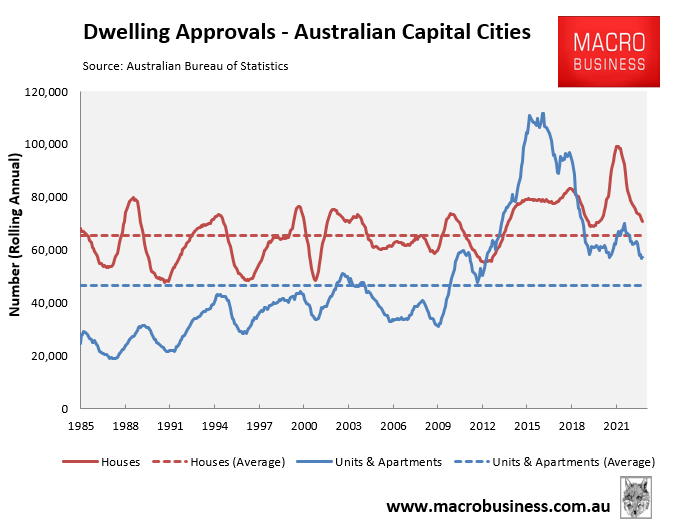YIMBYs, politicians, mainstream media, think tanks and developers are urging that Australia relax planning rules so that hundreds of thousands of apartments can be built across the ‘missing middle’ of Australia’s capital cities.
Their pleas ignore copious empirical evidence that the high-rise apartment boom experienced last decade was an unmitigated disaster.

Leading up to the COVID-19 pandemic, we witnessed reems of reports on the ‘crisis’ of flammable and defective apartments across Australia’s cities.
Building regulation consultant, Bronwyn Weir, warned “thousands and thousands of apartments have serious defects in their buildings. [The problem] is enormous”.
“We have what is now you know, a systemic failure that is quite difficult to unravel”, she said.
“Some of these buildings could potentially be a write-off”.
A survey released in October 2021 by the Strata Community Association NSW found that roughly four out of every ten new apartment complexes in NSW have serious faults.
A parliamentary inquiry in New South Wales discovered that building faults are widespread.
Similar systemic issues have been uncovered across Melbourne.
Earlier this month, The Age reported that “inspections of 339 buildings that received government funding to remove flammable cladding found half had other faults and one-in-four had balcony defects”.
“More than 550 balconies were found to be defective”.
“Cladding Safety Victoria is concerned that the situation in relation to defective balconies is widespread and has proliferated over at least two decades”.
“I believe the majority of issues are in the middle to low tier projects, largely in the apartment market. They have been built to an absolute minimum price and a minimum standard”, Association of Consulting Architects Victorian president Paul Viney said.
“I think we will continue to see significant numbers of building defects emerge”.
“The report said that 52% of the defective balconies were caused by water ingress, 19% had insufficient or no waterproofing and 10% were caused by lack of maintenance”.
Another article reported that “Victoria is facing a crisis of leaky buildings, with construction experts blaming a lack of regulation of waterproofing”.
“Since 2016 the big issue grabbing media and government attention has been combustible cladding … however the next big issue without a doubt will be water leaks, waterproofing and mould”, warned Joshua McDonald, a senior forensic engineer at Roscon.
Over the weekend, The ABC reported that the NSW Government continues to find faults in new apartment buildings, making the purchase of an apartment in a new development like a game of ‘Russian roulette’.
So far this year NSW Fair Trading has issued more than 30 work rectification orders across building sites, some for “potential serious defects”.
Engineer Leith Dawes said despite reforms in the building industry since the Mascot Towers saga, it remained a game of “Russian roulette” when purchasing off-the-plan.
“When it comes to really complex severe systemic defects, it’s just well beyond the average person to be able to size-up their building”, he said.
The proliferation of faulty apartments was driven by 15 years of pre-pandemic hyper-immigration, which required the construction of tens of thousands of extra homes every year, resulting in speed over quality and degraded building standards.
As illustrated in the chart above, the majority of dwellings constructed in Australia’s capital cities over the last decade were units and apartments.
The Albanese Government has now opened the floodgates to immigration, with a record 1.5 million net overseas migrants forecast to arrive in Australia by 2026-27, with the majority expected to settle in the major capital cities:

Source: 2023 Federal Budget
What will happen when we need to rapidly boost housing supply to meet unprecedented levels of immigration? Do we believe standards will remain the same, worsen, or improve?
The answer is obvious: building standards will be degraded in order to build apartments as rapidly as possible to house the swelling population.
More faulty high-rise apartments will be built across Australia’s cities to house the Albanese Government’s reckless mass immigration policy.

